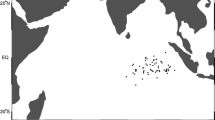Abstract
One of the greatest concerns for a successful catch in tuna fishing operations is the diving behavior of the purse seine. To analyze the integrated effect of fishing methods and sea currents on purse seine sinking depth, a multiple regression model was used. This improved model shows current speeds, shooting duration, the included angle between a two-layer current, and net mouth orientation relative to current direction (shooting angle) have an influence on maximum sinking depth. The current in the mid-layer is considered to significantly resist the seine’s vertical dive by a quadratic relation, but an increased shooting duration and shooting angle can be enhance the sinking. An obvious difference in terms of sinking depth is found between free-swimming school fishing and floating objects fishing, two common methods in tuna purse seine fisheries. It has been suggested that seine sinking dynamics respond to gear manipulation and, therefore, the model provides useful guidance in implementing net casting for an effective capture.







Similar content being viewed by others
References
Ben-Yami M (1994) Purse seining—FAO fishing manuals. Fish New Books, London, p 406
Kim YH, Park MC (2009) The simulation of the geometry of a tuna purse seine under current and drift of purse seiner. Ocean Eng 36:1080–1088
Konagaya T (1971) Studies on the design of the purse seine (in Japanese with English abstract). J Fac Fish Pref Univ Mie 8:209–293
Kim SJ, Park JS (1995) Characteristics of the motion of a purse seine. (1) The sinking behaviour of a model purse seine with different netting materials (in Korean with English abstract). Bull Korean Soc Fish Technol 31:362–371
Kim SJ (2004) An analysis of the sinking resistance of a purse seine. (2). In the case of a model purse seine with different netting material and sinker (in Korean with English abstract). Bull Korean Soc Fish Technol 40:29–36
Kim SJ, Park JS (1998) An analysis of sinking resistance for purse seine—in the case of model purse seine with different d/l (in Korean with English abstract). Bull Korean Soc Fish Technol 34:274–282
Shin J, Imai T, Fuwa S, Ishizaki M (1998) A model experiment on the characteristics of fishing gear of lampala net (in Japanese with English abstract). Nihon Suisan Gakkaishi 64:759–767
Bag JS, Aoyama T, Suzuki M (1986) Studies on the mackerel purse seine operating in the sea area of Cheju Island-2. Model experiment on the deformation of net in two layer current (in Korean with English abstract). Bull Korean Fish Tech Soc 22:32–40
Xu LX, Lan GC, Ye XC, Wang MF (2011) Effect of the leadline weight and net setting speed on sinking speed of the tuna purse seine (in Chinese with English abstract). J Fish China 35:1563–1571
Lee CW, Lee JH, Cha BJ, Kim HY, Lee JH (2005) Physical modeling for underwater flexible systems dynamic simulation. Ocean Eng 32:331–347
Kim HY, Lee CW, Shin JK, Kim HS, Cha BJ, Lee GH (2007) Dynamics simulation of the behavior of purse seine gear and sea-trial verification. Fish Res 88:109–119
Hosseini SA, Lee CW, Kim HS, Lee JH, Lee GH (2011) The sinking performance of the tuna purse seine gear with large-meshed panels using numerical method. Fish Sci 77:503–520
Riziotis VA, Katsaounis GM, Papadakis G, Voutsinas SG, Bergeles G, Tzabiras GD (2013) Numerical and experimental analysis of the hydroelastic behavior of purse seine nets. Ocean Eng 58:88–105
Hall M, Roman M (2013) Bycatch and non-tuna catch in the tropical tuna purse seine fisheries of the world. FAO fisheries and aquaculture technical paper, Rome, p 10
Fonteneau A, Ariz J, Damiano A, Delgado de Molina A (2010) Analysis of purse seine set times for FAD and free school associations in the Atlantic and Indian oceans. Collectiv Vol Sci Pap 65:620–626
Harley SJ, Suter JM (2007) The potential use of time-area closures to reduce catches of bigeye tuna (Thunnus obesus) in the purse-seine fishery of the eastern Pacific Ocean. Fish Bull 105:49–61
Schaefer KM, Fuller DW (2007) Vertical movement pattern of skipjack tuna (Katsuwonus pelamis) in the eastern equatorial Pacific Ocean, as revealed with archival tags. Fish Bull 105:379–989
Acknowledgements
This study was supported financially by the National High Technology Research and Development Program of China (No. 2012AA092302); the Project of First-Class Disciplines, Shanghai Universities: Eco-Friendly Fishing Gear and Fishing Methods in the Field of Fisheries Science (B-5005-12-0001-4C), and the special funding for the development of science and technology of Shanghai Ocean university (No. a2020914200060).
Author information
Authors and Affiliations
Corresponding author
Rights and permissions
About this article
Cite this article
Zhou, C., Xu, L., Tang, H. et al. In-situ dynamics of tuna purse seine deployment in various operations and currents. Fish Sci 81, 1003–1011 (2015). https://doi.org/10.1007/s12562-015-0918-z
Received:
Accepted:
Published:
Issue Date:
DOI: https://doi.org/10.1007/s12562-015-0918-z




